|
Getting your Trinity Audio player ready...
|
Established in 1994
Take a trip through the unique landscape of Joshua Tree National Park. Wander through flourishing cacti gardens, explore rocky canyons, and take in the beauty of star-filled night skies. This magical desert sight is not to be missed.
Overview
Joshua Tree National Park is a mythical, magical desert lifted straight from a legend. The untrained eye might see an expanse of barren rock baking in the summer sun, scattered sparsely with the odd-looking trees the park is named for.But there is much, much more going on behind the curtain here.
Tucked away in pockets of this apparently lifeless waste are oases, where gigantic palm trees sway in the coastal wind. Insects, amphibians, birds, mammals, and reptiles creep, buzz, and crawl. Silent canyons turn blue under the milky light of the night sky. The sand, rock, and trees seem to hum with an ethereal energy.
To really get the picture, you need to see it firsthand. But before you get whisked away to this fantasy landscape, there are a few things you should know.
And lucky you, I’ve compiled everything you need to have an amazing trip to Joshua Tree right here. All the reasons the park is great, and everything you need to know to enjoy it. Let’s dive in.
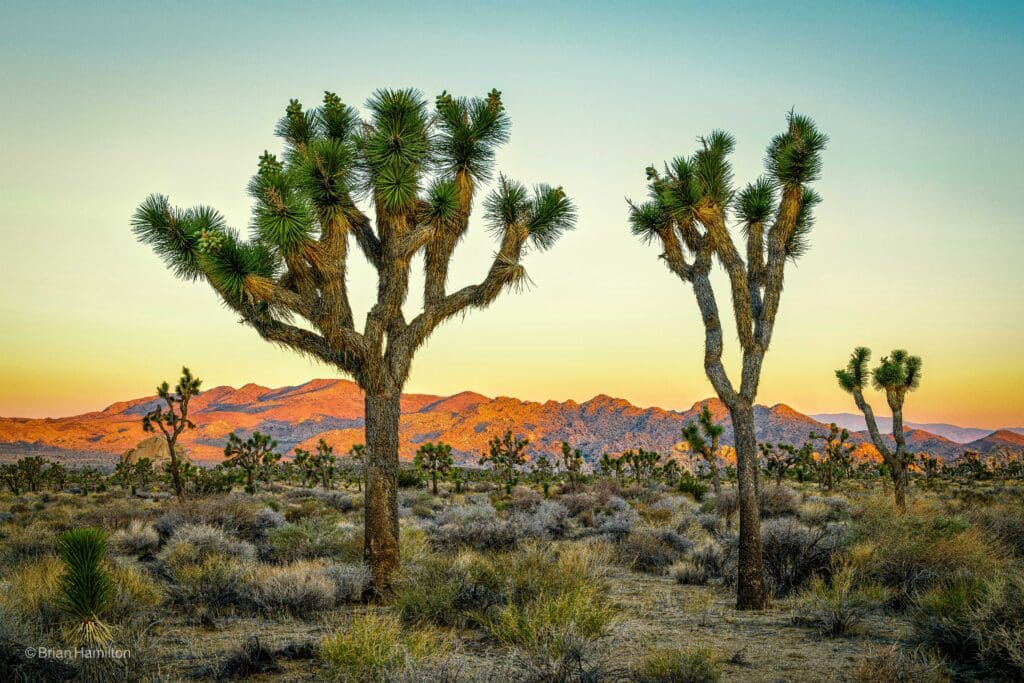
Joshua Tree National Park
Table of Contents:
Article Navigation: Click on any of the listed items in the table of contents below to jump to that section of the article. Similarly, clicking on any large, white section header will jump you back to the Table of Contents.
- Overview
- Human History
- Ecology
- Best Places to Stay
- Enjoying The Park
- Getting to the Joshua Tree National Park
- Conclusion – Pure Desert Magic
Humans History
Joshua Tree’s story starts way, way back.
Native Peoples
The area’s first residents were the Pinto Culture, who first moved in around 10,000 years ago. Down the road a ways, three distinct cultures of people (the Serrano, Cahuilla, and Chemehuevi people) coexisted in and around Joshua Tree.
The park’s oases were crucial to these early cultures. In particular the Oasis of Mara, which was later called Twentynine Palms. They hunted small game and used local plants for medicine and tools.
But, as is almost always the story in the Southwest, the arrival of Spanish missionaries put an end to their way of life.

A mortar and pestle embedded in a granite boulder, known as a mono and matate, found in Joshua Tree National Park. The stones were rumored to have been used by ancient tribes for preparing food or making medicine.
War, Industry, and Conservation
When Mexico won its independence, the park sat within its boundaries. But the land changed hands again after the Mexican-American War, along with the rest of California.
The latter half of the 1800s brought grazing to the region, changing the ecology of the park permanently. The mining industry followed shortly after.
Around 300 small pit mines dotted the landscape, which produced gold and silver, among other metals. Mining left a lot of scars on the land, but also some very interesting ruins and historical sites that you can visit today.
In the early 1900s, local activist Minerva Hoyt made a persuasive argument to protect the area. President Roosevelt took notice and established Joshua Tree National Monument in 1906. The Monument wouldn’t receive park status until 1994 under the Desert Protection Act.
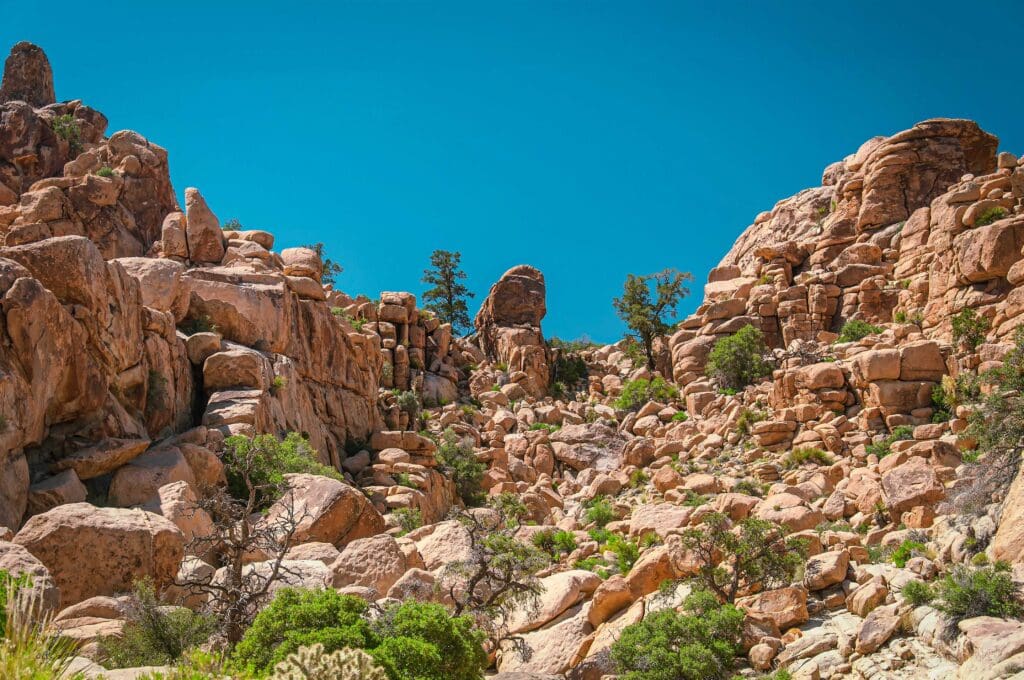
The rocky and rugged landscape on the hidden valley trail in Joshua Tree National Park.
The Ecology Of Scarcity
Joshua Tree National Park is part of the charismatic, harsh, hot, and dry Mojave Desert, as well as the Colorado Desert. The park is roughly half and half, the western half being Mojave, and the east being Colorado.
It’s a wild life living in such a desolate place, with so little water and so much sun. But there are a lot of animals and plants that thrive here.
In any hot desert, life is an obsessive search for water. How to get it, how to keep it, and how to survive until you can get more of it. It’s almost always an all-or-nothing cycle of feast and famine.
Joshua Tree Seasons
Joshua Tree has two seasons: rainy, and rainless. The rainless season lasts almost nine months, from mid-March to December. The rainy season makes up the “winter” months, and is usually still very dry.
Rainfall usually amounts to a drizzle in the winter. Trickles of water will fill perennial pools in shady places, drawing fauna from their hiding places to drink. Once the rain turns off in March, the majority of the landscape turns bone dry.
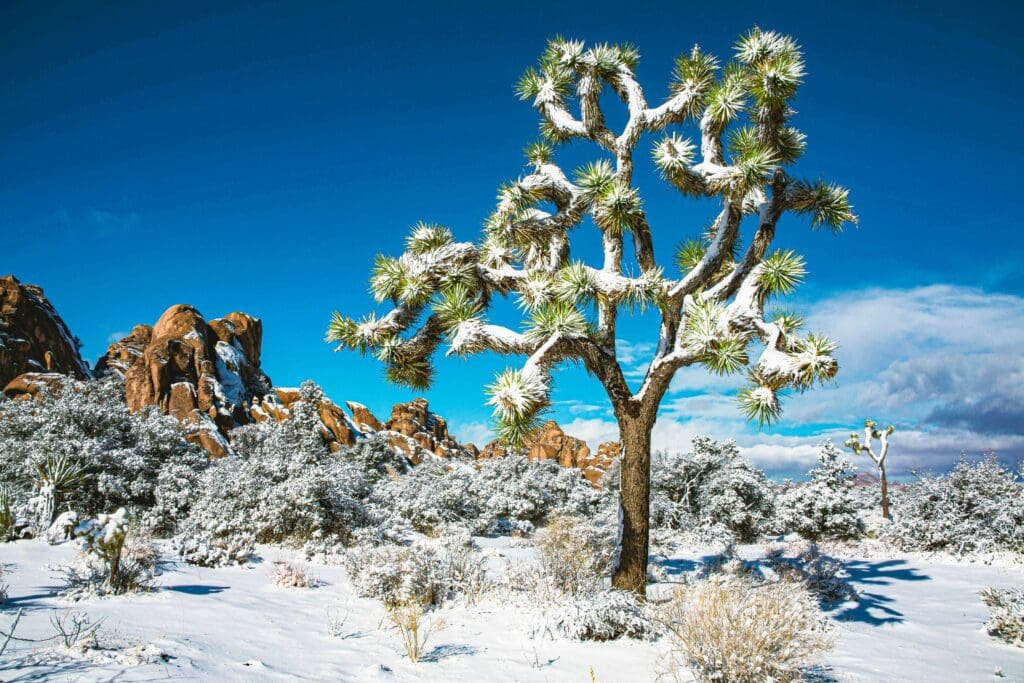
Joshua Tree National Park just after a winter storm.
Monsoons And Flash Floods
However, that’s not always true. Joshua Tree does have a monsoon season, during the late summer and early fall, when flash floods can happen. The golden rule for visitors is, “if you see running water, get out.” Sounds ominous, right?
The reason is that if there’s enough water to flow, there’s more behind it. Desert landscapes tend to feature narrow channels, where the rainfall on an entire mountain face gets funneled and crashes down with the force of a natural disaster. This is the epitome of “all or nothing.”
When flash floods roll through an area, years worth of weathering will happen overnight. You can sometimes return to a place after it has flash flooded to find it completely unrecognizable.
Canyons and washes are worn down, mud and rock are carried, and trees can be completely uprooted. Ironically for a place where life is so dependent on water, flash floods are often deadly for plants and wildlife (not to mention people).
Oasis Ecology
There is another, significantly less dangerous source of water in Joshua Tree, though. A lot of the park’s biodiversity is due to the oases that dot the landscape. These little pools create entire ecosystems and support populations of unique plants and wildlife, like the desert fan palm tree, which can reach 70 feet tall.

Sunrise view of hundred-year-old palm trees at the Fortynine Palms Oasis Trail in Twentynine Palms, California.
The oases support amphibians, like the red-spotted toad, and allow hundreds of species of insects and arachnids to reproduce. These invertebrates, in turn, feed everything above them on the food chain.
Most of the park’s mammals (particularly the diverse bats and rodents), birds, and reptiles are supported by insect life. And the insects depend on the permanent water found in the oases.
So if you were to take away the oases, what would we be left with? Not much, honestly. Ecologically, the park would lose a majority of its biodiversity, not to mention its character. The hot sun makes this place a desert, but the oases are what really make it Joshua Tree.
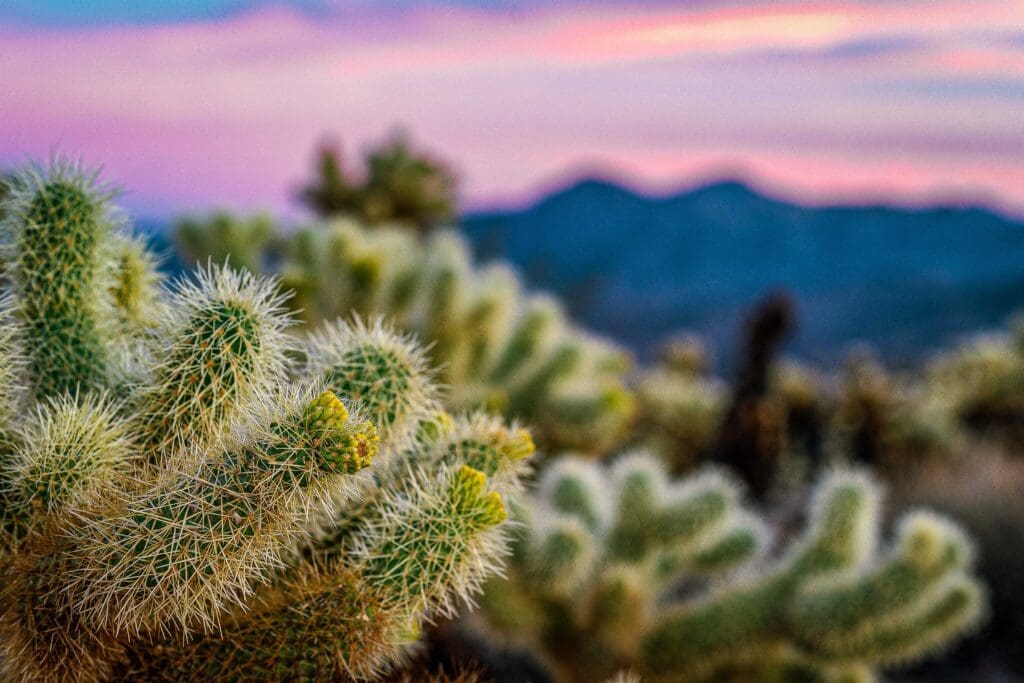
Cholla Cactus Garden Sunset in Joshua Tree National Park
Weird, Wild Desert Geology
When you think of Joshua Tree, you probably don’t even think of Joshua trees. The park’s most charismatic feature by far are the gigantic formations of whitish rocks.
Older Than Dirt
Not quite hills, definitely not mountains, but also certainly bigger than your common boulders. The rock formations of Joshua tree are old. How old, millions of years? Not even close. In fact, the oldest stone in Joshua Tree (the Augen Gneiss unit) is around 1.7 billion years old.
Like with most beautiful things in California, these formations are the result of the San Andreas Fault. This is where the continental tectonic plate meets with the Farallon Plate that the ocean sits on.
Converging Plates
The pressure of these converging plates produced a huge amount of magma underground, which cooled and formed a bunch of really cool rocks. Around Joshua Tree, you’ll find several kinds of gneiss, as well as metasedimentary rocks.
Metasedmintary rock is metamorphic, but was sedimentary before its metamorphosis. If you’re really into rocks, there are a lot of cool things to be on the lookout for, like ganofels, dolostone, and dolomite.
The Artist’s Chisel
But to climbers, the ancient history of the place is only important because it formed such perfectly climbable walls and boulders. After the subterranean magma layer cooled into stone, groundwater seeped down and cut through it.
Slowly but surely, the rock was worn into the aesthetic rounded shapes that we see above ground. Then weathering exposed these newly-formed stones as they were uplifted, resulting in the landscape of mountains, valleys, and rock outcroppings we see today.

The ancient history of the place only matters to climbers because it formed perfect walls and boulders.
Best Places to Stay
Hotels
Joshua Tree National Park offers a variety of accommodations, catering to different preferences and budgets. For those looking to stay as close as possible to the park, the best options include:
- Joshua Tree (Village): This is the overall best place to stay near Joshua Tree National Park. It’s a small community right outside the park’s entrance, offering a laid-back atmosphere perfect for relaxation. Many excursions into the national park also depart from Joshua Tree Village, making it a convenient choice if you don’t plan on taking a car into the park.
- Desert Hot Springs: Ideal for couples, this town is known for its natural hot springs and spas. It’s a perfect place to unwind and enjoy some relaxation time in the desert.
- Twentynine Palms: This area is recommended for families. It’s close to the park’s northern entrance and offers a creative hub with murals and art galleries to explore. It’s also known for its stargazing views.
For those looking for unique and memorable stays, consider glamping options like AutoCamp Joshua Tree and Sacred Sands, which offer a blend of luxury and the outdoor experience. These accommodations are particularly popular for their proximity to the park and their distinctive atmospheres.
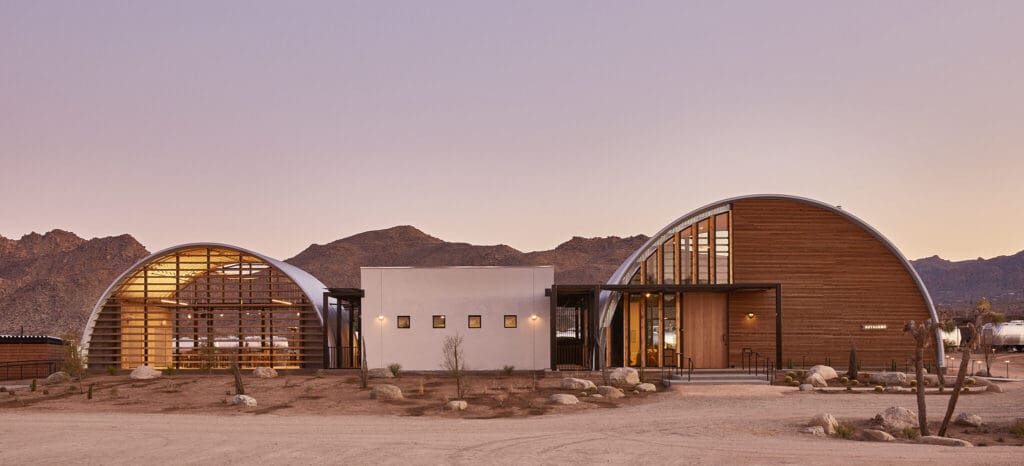
AutoCamp Joshua Tree is a unique and luxurious camping experience that offers a blend of the outdoors and modern comforts. Photo: AutoCamp Joshua Tree.
Joshua Tree Camping
You can’t go to the desert without laying out under the stars. You just can’t! The night sky in Joshua Tree is too good to miss.
Most of the camping in the park is on the western side, in the Mojave region of the park. There really are no wrong answers as far as camping in Joshua Tree goes, but there are a few standout spots to pitch a tent.
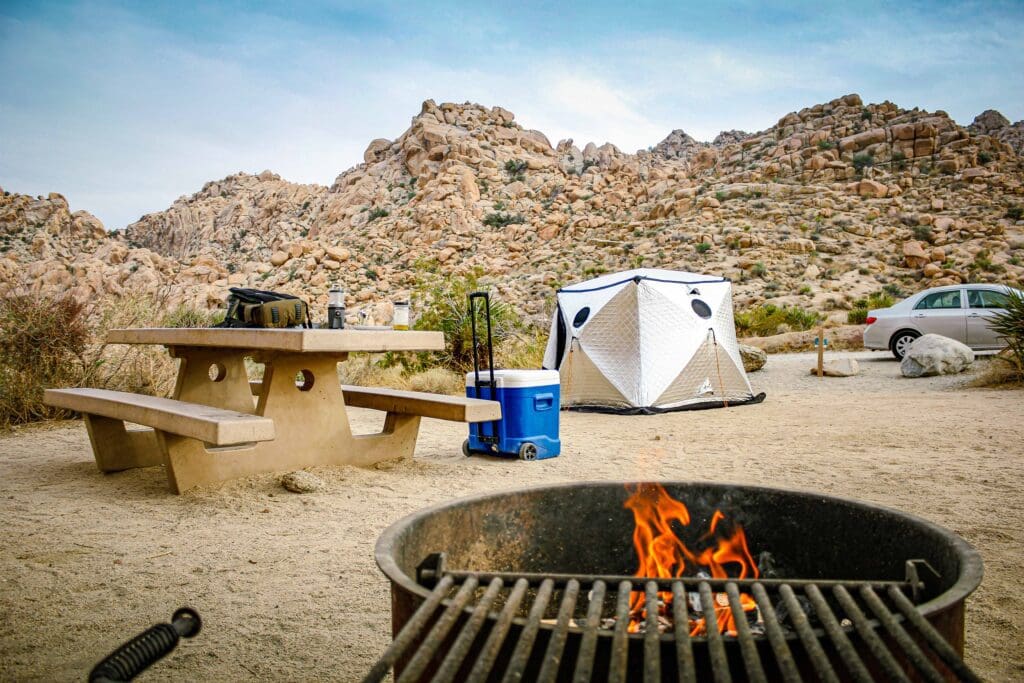
A view of a campground among the rocky terrain of Joshua National Park.
Hidden Valley Campground is probably the most scenic spot in the park. The sites are surrounded by top-notch boulders and rock formations that are a ton of fun to scramble and goof around on.
The location is also pretty prime. Hidden Valley is right in the middle of the action on the west side of the park, with lots of hikes and climbing nearby to enjoy.
The campground has 44 sites, with a mix of RV and tent sites. There are no reservations here, just first-come-first-served sites. Show up early to snag a good one. No potable water is available, so bring plenty with you.
Belle Campground is a little further east, but still an ideal spot to pitch a tent and lay out. The scenery is similar to Hidden Valley, with tall Joshua Trees and tall rock for some partial shade.
The location puts you close to Jumbo Rocks, Skull Rock, and the Split Rock Loop Trail. Lots to explore and enjoy, without quite so much traffic around.
Belle Campground is pretty small, with just 18 sites (options for tents and RVs), all first come first served. There’s no water out here, so be sure to pack in plenty of your own, or fill up at the ranger station a few miles north.
Jumbo Rocks Campground is the park’s biggest. Big rocks, and a big spread with lots of sites. It’s a reservation site (from September to May), so if you’re planning way in advance, this is a great option.
There’s not a ton of climbing right around the campground, but there are a lot of sweet nooks and crannies to explore. You’ll also be in the neighborhood of all the same hikes as Belle Campground.
The campground has a total of 124 sites, with a mix of tent, RV, and group sites. No water is the norm around here, if you haven’t noticed already. But you can always fill up at the ranger station a few miles up the road, or pack it in.
Enjoying the Park
Best Times To Visit Joshua Tree National Park
As I mentioned, the weather conditions in Joshua Tree National Park are pretty stable year-round. There’s never a “bad” time to visit, but there are a few times when you might need to prepare a little more.
The most extreme time of year is mid-summer, particularly from June to August. Daily temps average above 95°F every day for this three month stretch. But, this is also when the park sees the fewest visitors. So if you’re after some serious solitude, it might be worth it to brave the heat.
The rest of the year is usually very temperate in Joshua Tree. December has the lowest temps, dropping to 35°F on average at night, and reaching just under 60°F during the day. January, February, July, and August all tie for the “rainiest” with a whopping half inch of rain per month.
March and April are the busiest months, with 431,000 and 358,000 visitors, respectively, in 2022.
Given all that, I recommend going in the fall or winter. Bring a good sleeping bag and an extra layer, and enjoy the pleasant sun during the day. You’ll have more space to yourself, and the weather will be perfect for hiking and climbing.
The Best Things To See In Joshua Tree National Park
Alright, crash course time. If you’ve got a long weekend and you need to hit the highlights, what’s worth your time in Joshua Tree National Park? Lace up your hiking shoes, let’s go for an adventure.
Hidden Valley
Hidden Valley is a perfect spot to give you a general vibe for what Joshua Tree is all about. It’s easily accessible and full of the kind of scenery the park is famous for. Joshua trees sprawl among rocky outcroppings that are (go figure) full of climbing routes.
But even if you don’t climb, it’s worth the short hike, just to see what this fantastic desert landscape looks and feels like.
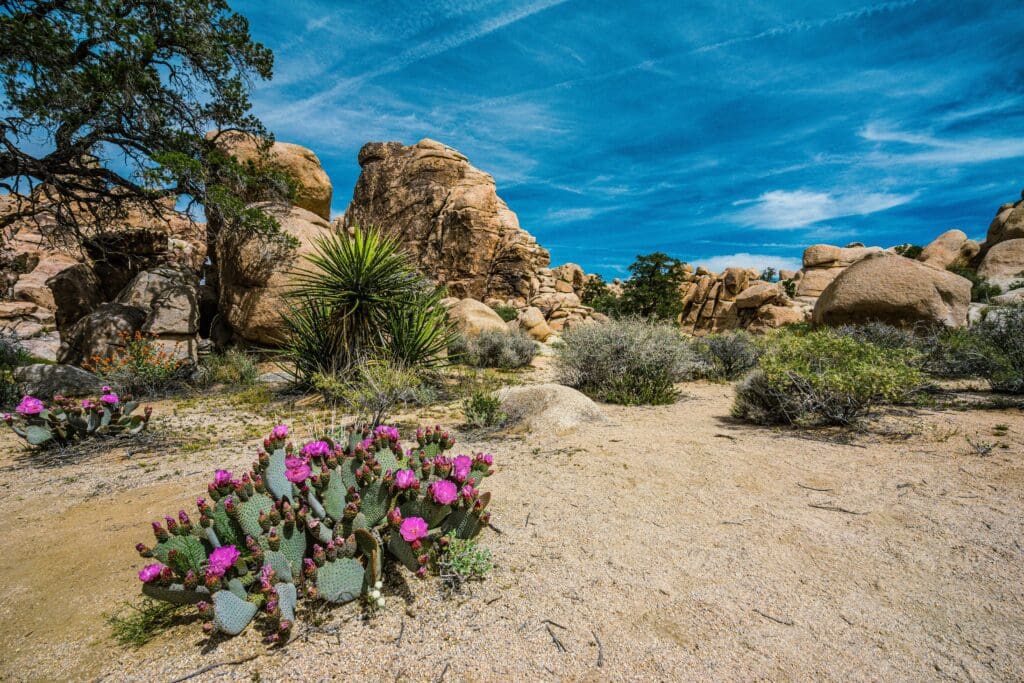
Hidden Valley Nature Trail in Joshua Tree National Park
Fan Palm Oases
I really can’t overstate how cinematic the oases in Joshua Tree are. They’re exactly what you picture when you think of an oasis; sleepy, cool pools of water buzzing happily with the sounds of life. It’s a nice diversion from the harsh sun and hard rock of the surrounding landscape.
There are six oases around the park. The Oasis of Mara is the easiest to get to, just a half mile hike from Ryan Ranch Trailhead. If you’re feeling a little more adventurous, Fortynine Palms Oasis is about three miles round trip, but well worth it.

Fan Palm Trees (Washingtonia filifera) in the Lost Palms Oasis, a popular hiking spot, Joshua Tree National Park
Keys View
Keys View has got to be one of the best panoramas in Joshua Tree, and it’s certainly the easiest to get to. Bang for your buck-wise, it doesn’t get much better than this in the park. The view includes the San Andreas Fault, Mt. San Jacinto and San Gorgonio Mountain. It’s a splendid spot to catch a sunset or sunrise.

Joshua Tree National Park Keys View summit at sunset, a high viewpoint with palm trees, Coachella Valley, boulders and mountains.
Incredible Rock Formations
There are a few stand-out rock formations in the park that are well worth a short hike.
Skull Rock Trail is a 1.7 mile loop near Twentynine Palms ending at the titular Skull Rock. Go figure, it looks like a gigantic skull. A foreboding personification of the harsh spirit of the desert, picturesque as it is spooky.
Arch Rock is a naturally-formed arch like you might find in Southern Utah. But it’s very out of place in a landscape of granite, rather than sandstone. The trailhead departs Pinto Trail Rd and heads east about .7 miles before looping back. A great romp through the sand and rocks to a photogenic payoff.

Arch Rock in Joshua Tree National Park.
Looking For An Amazing Adventure? Book A Guided Hiking, Backpacking or Cycling Tour in Joshua Tree National Park with REI Adventures.
Best Desert Hikes and Backpacking Trails
Unlike somewhere like Death Valley, where the inescapable sun puts a damper on hiking anywhere, hiking Joshua Tree is a blast. And that’s a good thing, because most of the stuff worth seeing takes a little legwork (pun intended) to get to.
Here are the highlights, for hikers of every fitness and experience level.
Beginners new to hiking should absolutely go after all the trails I’ve mentioned so far. You’ll get a lot of enjoyment out of the park’s main attractions.
But there are a few other short hikes that are well worth your time. The Cholla Cactus Garden is definitely one of the prickliest places on Earth, but it’s pretty marvelous to behold.
And if you get a kick out of old buildings and broad, open views, check out Ryan Ranch. The trail features sweeping desert landscape views, capped off with an old adobe structure that looks right at home among the park’s rock formations.
Intermediates can throw some scrambling into the mix on the Mastodon Peak Trail. This loop climbs a bit, with a little hands-on scrambling to gain the peak. Then you’ll pass an old gold mine as you head back to the trailhead.
Lost Horse Mine is another decent climb, covering a total of 4.1 miles out and back. It’s got some great views, and another historical gold mine along the way. If you want to tack on some extra mileage, check out the loop variation.
Last up, don’t overlook the Hi-View Trail. You’ve got two options here, a 1.4-miler from the parking lot, or a 3-miler from the visitor center. Sweeping views of desert scenery and distant high peaks ensue. A nice bit of soothing desert solitude for those who like it quiet.
Experts would be remiss not to seek out some of the park’s deeper, harder-to-access oases. Fortynine Palms is a three mile out and back ending in one of the park’s most spectacular oases.
Be warned though, people have died hiking this trail. It’s always a pertinent reminder, but it bears repeating here to bring water with you and know the signs of heat exhaustion. Getting hauled out by search and rescue is not the worst outcome in the desert.
Ryan Mountain is another worthy high point in the park. It gains about 1,000 feet over 1.5 miles or so, which will feel like a lot more in the sun. For experienced hikers, this one is a must-see, and one of the best views in the park.
And if you’re just aching for some more trail miles, check out Lost Palms Oasis. This one starts on the Mastodon Peak Loop, but passes up the high point and charges on through clusters of Joshua trees. The terrain rolls in and out of washes, before ending at a placid oasis.
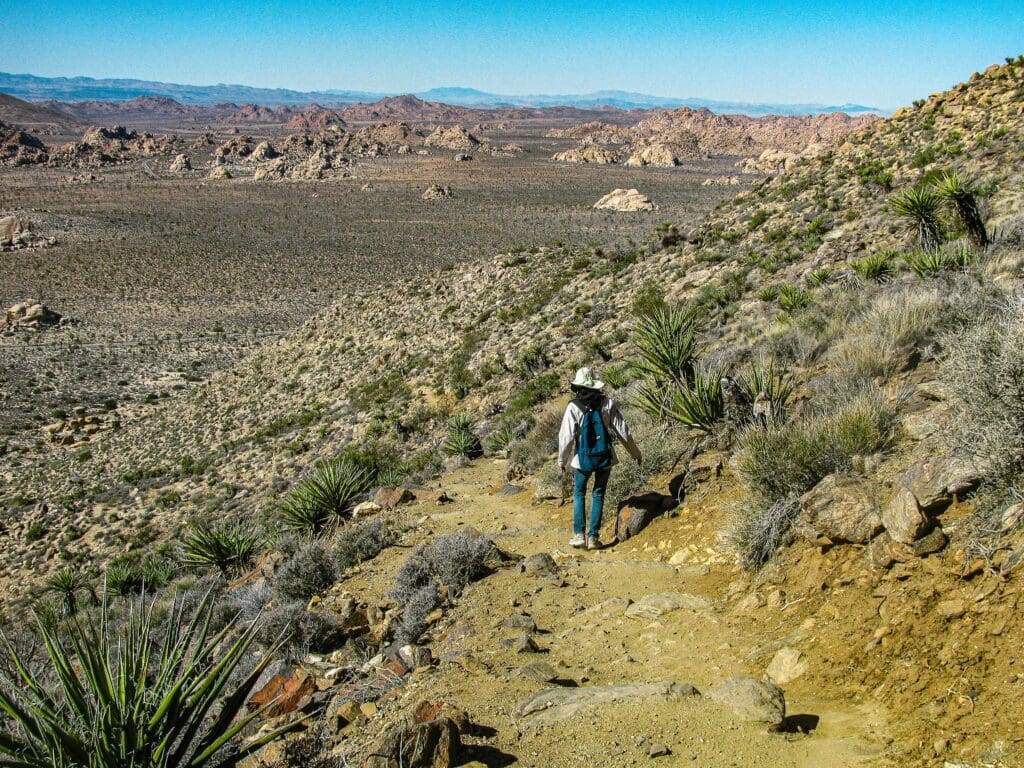
A hiker on the popular Mt. Ryan Trail in Joshua Tree National Park.
Backpacking
Backpacking in Joshua Tree is no joke. The heat here can be deadly, and the lack of water is a huge challenge.
When planning a backpacking trip, normally you would pick a trail, get a permit, and go from there. In Joshua Tree, the park allows you to plot your own route. Off-trail hiking is allowed, provided you minimize your impact.
Most backpackers will plan routes around hiking and camping on rock or in wash bottoms. The most important rule here is to Leave No Trace. Pack out your waste, camp on durable surfaces, don’t start fires, and so on.
The most popular area for backpacking in the park is called Boy Scout. This includes the Boy Scout Trail, a relatively short trek with designated campsites. If you’re looking for simple and low-commitment, this is a good spot to start.
But if you’re after a little bit more adventure, you’ve got a lot of research ahead. Start by checking out park regulations for backpacking, which includes rules for parking, planning a route, and permitting.
J-Tree Rock Climbing
If you’re a climber, you’ll probably refer to Joshua Tree National Park simply as “J-Tree”. This area is revered by climbers near and far for its amazing conditions during the off-season and excellent rock quality.
And on top of that, there’s just so much climbing to do. Go figure! Just about everywhere you look, there are rocks.
The real bread and butter of Joshua Tree is bouldering and trad climbing. Pack a full rack of trad gear and a few bouldering pads, depending on your mood.
But there is still a little sport and toprope climbing for newbies who aren’t ready for highball boulders and sketchy runouts quite yet.
It would take an actual lifetime to see all the climbing there is to do in the park. These are just a few of the highlights, good starting places for climbers of all ability levels.

Jumbo Rocks close to sunset in Joshua Tree National Park.
Beginners (especially beginner boulderers) have a ton of options in Joshua Tree.
White Rastafarian is the park’s most famous boulder problem. And it’s an easy one, at least technically. The crux is the height.
Pigpen is another killer problem, found on the Manx Boulders Circuit. Rated V4, this one could be called beginner or intermediate, depending on who you ask. It’s a fun start in a cave that swings up and on to a flat face before topping out.
The Southwest Corner of Headstone Rock is an easy peasy 5.6 sport route with bomber holds and great protection. Check out Cryptic while at Headstone Rock as well.
Double Cross, found on the West Face of Old Woman, is a nice trad intro if you’re trying to get better at leading trad. Rated 5.7+, it features a nice hand crack. The downside is a sizable line which is usually present. It’s popular, but for good reason.
Intermediates also have a ton of options to pick from in J-Tree. But once you get above 5.8 or 5.9, most of the “good” routes are trad. Sorry, sport climbers.
Illusion Dweller is a must-see on the West Face of Sentinel Wall. A right-angled hand crack that incorporates a bit of laybacking. The way back down is either a rappel or a walk-off, dealer’s choice. Rated 5.10b.
Rubicon is the most popular route on the Rubicon Formation. Lots of good nut placements, some finger crack action, but good feet for a little more support. Rated 5.10c.
Steadily climbing the spice-o-meter, JBMFP is a nice 16-foot problem up JBMF boulder. If you need a little warm-up, there are a few easier problems to the right and left to get you pumped up.
Caveman, on Caveman Boulder, is a very picturesque problem starting in a cave with grippy huecos for holds, but worse feet. Looks easy from a distance. Looks can be deceiving. A fun project, either way, at V7-.
Experts, prepare for a challenge. The rankings may not seem impressive. But if you haven’t climbed in the desert before, you’ll quickly realize the major difference between a 5.12 crack route and a normal 5.12.
Caveman Yabo, another high-intensity romp up Caveman Boulder, pushes through Caveman and adds another dozen moves or so, totaling about 40 feet, including the cave. V10.
Thin Lizzie is a popular problem on Lizzie Boulder featuring back-to-back dynos. It’s not too tall, luckily, so just go for it! V8.
Leave it to Beaver (Sports Challenge Rock) measures about 70 feet of stuff you typically don’t see all in one place. Deep pockets, horizontal cracks, overhangs, and a lot of weirdness all put together for a very fun route. Typically rated 5.12a, you can approach this one with trad gear, or just hike up top and do it on a toprope.
Asteroid Crack, found on Asteroid Belt, is a short-but-sweet vertical finger crack that gets thinner as you go. On top of everything, there’s a slight overhang near the top. 30 feet is plenty for something this spicy. Rated 5.13a.
Mountain and Road Biking
Biking is a great way to explore desert landscapes. The main rule in the park regarding bikes is to stay on roads. Luckily, there are a ton of roads, both paved and dirt, around the park.
Road cyclists can have a ton of fun cruising through the desert landscape, enjoying the views. There are some big climbs and downhill sections on the paved roads, so be prepared to sweat it out.
But mountain bikers will have a lot more opportunity to see the less-often explored nooks and crannies of Joshua Tree. There are quite a few high clearance dirt roads that venture into the backcountry around the park.
Most of these are pretty short, maxing out around 23 miles (Old Dale Road). The majority of them average 5-10 miles.
One of the more popular trails for mountain biking in the park is the Geology Tour Road, beginning at Jumbo Rocks Campground. It’s just two miles, and includes some fantastic mountain views along the way.
Berdoo Canyon is a longer, more technical, and even more rewarding route. It measures 11.5 miles one way. Be prepared for deep sand and some rock hopping. But the payoff is pretty cool – the Berdoo Camp, a historic ruin tucked away deep in the mountains.
If you want some more aggressive downhill and stretches where you can really put the pedal to the metal, you’ll have to leave the park. Desert View Conservation Area is located just outside the park boundaries. It contains a more traditional network of trails designed for mountain biking, with options for all ability levels.
4X4 and Off-Roading
The same options that are open to MTB folks are open to motorheads. Check out the park’s backcountry roads page, and do as much reading as you can before you go.
There are a few pretty technical trails in Joshua Tree, but for the most part the difficulty comes from road surfaces and isolation. There is a lot of deep sand, which can be challenging for drivers that are unfamiliar with offroading in the desert.
Beyond that, though, you need to be prepared to self rescue. Don’t expect to have cell service once you get into the backcountry. If you get stuck, the heat may get to you before help can. Be prepared for trail repairs and with enough gear to self-recover, if need be.
That being said, here are the highlights.
If you just want to get a little dust on the fenders, check out Berdoo Canyon. It’s got a bit of everything: sand, sharp rock, rock crawling, and even a choke point that will weed out larger offroad rigs. Not recommended for those unfamiliar with driving in deep sand.
The Old Dale Road is a full day. It starts with a long trek across a flat salt pan, which may include deep sand. Then, you come to a hill and start climbing.
There is some rock crawling, mixed with some sections of loose rock which is challenging in a different way. You’re going to want a short wheelbase, for starters.
Last up is PInkham Canyon and Thermal Canyon. This is one of the toughest trails in the park, featuring just about everything I’ve mentioned already. Deep sand, some rock crawling, loose gravel, bottlenecks, you name it. But once you top out, you’ll be rewarded with some amazing views.
Nature Watching
Step one, go to nature. Step two, look at the nature. This one almost goes without saying, but there is a lot of unique natural splendor to see in Joshua Tree.
Birdwatching
Joshua Tree National Park is home to more than 250 bird species. A large number of these, if not a majority, are migratory birds that use the park seasonally.
What this means to birders is that you never know what you might see in Joshua Tree. The species list is ever-rotating, and you can have a completely different experience birding at different times of the year.
Of course, the big event of the year for birdwatchers is the Audubon Christmas Bird Count. And because it’s so warm in the winter, Joshua Tree is a perfect place to be for this birding extravaganza.
Stargazing
Joshua Tree is a big destination for astrophotographers and stargazers. The area is renowned for its lack of light pollution and is an International Dark Sky Park.
The stable climate also makes it a stellar spot to study the night sky. The sky is often clear, and warm nighttime temps make for very comfortable skywatching conditions.
Whether you’re into astrophotography, long-exposure photography, or just enjoying the vastness of space, be sure to set aside some time at night to enjoy the sky.

Perseid Meteor Shower in Joshua Tree National Park
Spring Wildflowers
Similar to Death Valley National Park, Joshua Tree sometimes sees super blooms of perennial wildflowers. Wildflowers are a seasonal surety, but the scale of the spectacle mostly depends on rainfall.
The park usually forecasts what the spring bloom will be like. During good years, when the El Niño Southern Oscillation is favorable, the park transforms into a landscape of color. If you have the opportunity to see the park dressed in wildflowers, don’t pass it up.
Getting to the Joshua Tree National Park
To get to Joshua Tree National Park, you have several options depending on your starting location. The park is located within a few hours’ drive of several major metropolitan areas, approximately 140 miles east of Los Angeles, 175 miles northeast of San Diego, 215 miles southwest of Las Vegas, Nevada, and 222 miles west of Phoenix, Arizona.
There are two main approaches to the park: via Interstate 10 or California Highway 62 (the Twentynine Palms Highway). The West Entrance is located five miles south of the junction of Highway 62 and Park Boulevard at Joshua Tree Village, while the North Entrance is in Twentynine Palms, three miles south of the junction of Highway 62 and Utah Trail. The South Entrance near Cottonwood Spring is an access point along Interstate 10, 25 miles east of Indio.
If you’re navigating to the park, be cautious and avoid relying solely on GPS directions, as they can sometimes direct you onto backcountry roads that may not be suitable for regular vehicles. It’s best to use the main park entrances and follow the directions provided by the park’s official website or reliable mapping services.
For specific directions based on your starting location, you can use online mapping services or GPS navigation systems, but always double-check the route against official park information to ensure a smooth and safe journey.
Pure Desert Magic
Once you get a taste for Joshua Tree, you’ll understand why so many people feel connected to this place. It’s like a lot of deserts in the American West in that it almost feels alive.
Don’t believe me? Ask a local what keeps them coming back for more, year after year.
If there was ever magic in the world, Joshua Tree is full of it. All you need to do to find it is look, and listen.











